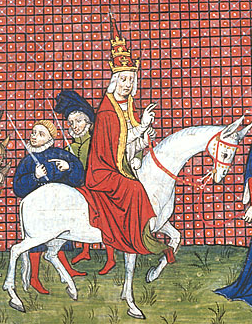
Pope Gregory XI was head of the Catholic Church from 30 December 1370 to his death, in March 1378. He was the seventh and last Avignon pope and the most recent French pope recognized by the modern Catholic Church. In 1377, Gregory XI returned the Papal court to Rome, ending nearly 70 years of papal residency in Avignon, France. His death shortly after was followed by the Western Schism involving two Avignon-based antipopes.
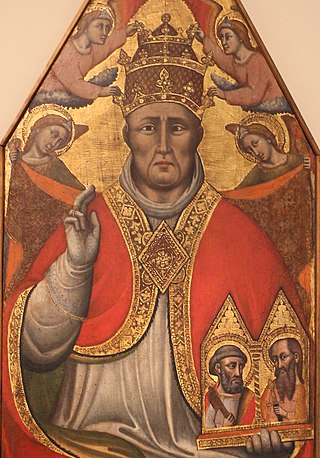
Pope Urban V, born Guillaume de Grimoard, was the head of the Catholic Church from 28 September 1362 until his death, in December 1370 and was also a member of the Order of Saint Benedict. He was the only Avignon pope to be beatified.

The Avignon Papacy was the period from 1309 to 1376 during which seven successive popes resided in Avignon rather than in Rome. The situation arose from the conflict between the papacy and the French crown, culminating in the death of Pope Boniface VIII after his arrest and maltreatment by Philip IV of France. Following the subsequent death of Pope Benedict XI, Philip forced a deadlocked conclave to elect the French Clement V as pope in 1305. Clement refused to move to Rome, and in 1309 he moved his court to the papal enclave at Avignon, where it remained for the next 67 years. This absence from Rome is sometimes referred to as the "Babylonian captivity of the Papacy".

Guy de Malsec was a French bishop and cardinal. He was born at the family's fief at Malsec (Maillesec), in the diocese of Tulle. He had two sisters, Berauda and Agnes, who both became nuns at the Monastery of Pruliano (Pruilly) in the diocese of Carcassonne, and two nieces Heliota and Florence, who became nuns at the Monastery of S. Prassede in Avignon. He was a nephew of Pope Gregory XI, or perhaps a more distant relative. He was also a nephew of Pope Innocent VI. Guy was baptized in the church of S. Privatus, some 30 km southeast of Tulle. He played a part in the election of Benedict XIII of the Avignon Obedience in 1394, in his status as second most senior cardinal. He played an even more prominent role in Benedict's repudiation and deposition. Guy de Malsec was sometimes referred to as the 'Cardinal of Poitiers' (Pictavensis) or the 'Cardinal of Palestrina' (Penestrinus).
Pietro Colonna was an Italian cardinal.

The 1464 papal conclave, convened after the death of Pope Pius II, elected as his successor cardinal Pietro Barbo, who took the name Paul II.
Francesco Carbone Tomacelli was Italian cardinal at the time of the Great Western Schism. He was nephew of Pope Boniface IX.

The 1404 papal conclave – the papal conclave of the time of the Great Western Schism, convened after the death of Pope Boniface IX, it elected Cardinal Cosimo Gentile Migliorati, who under the name of Innocent VII became the third pope of the Roman Obedience.

The 1406 papal conclave, the papal conclave of the time of the Great Western Schism, convened after the death of Pope Innocent VII. It elected Cardinal Angelo Correr, who under the name of Gregory XII became the fourth pope of the Roman Obedience.

The papal conclave held from 16 to 18 December 1352 was convened after the death of Pope Clement VI and elected as his successor Cardinal Etienne Aubert. The fifth pope of the period of the Avignon Papacy, he took the name Innocent VI. This conclave is remarkable because during its celebration cardinals for the first time in history subscribed the electoral capitulation, which limited the power of elect.
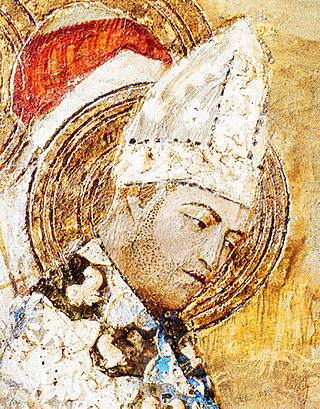
The papal conclave held from 5 to 7 May 1342 was convened after the death of Pope Benedict XII and elected Cardinal Pierre Roger to succeed as pope. The fourth pope of the period of the Avignon Papacy, he took the name Clement VI.

Angel de Grimoard, also recorded as Angelic or Anglic, was a French canon regular and a Cardinal. He was the younger brother of Pope Urban V.

The papal conclave held from 1 May 1314 to 7 August 1316 in the apostolic palace of Carpentras and then the Dominican house in Lyon was one of the longest conclaves in the history of the Roman Catholic Church and the first conclave of the Avignon Papacy. The length of the conclave was due to the division of the cardinals into three factions: Italian, Gascon, and French/Provençal.
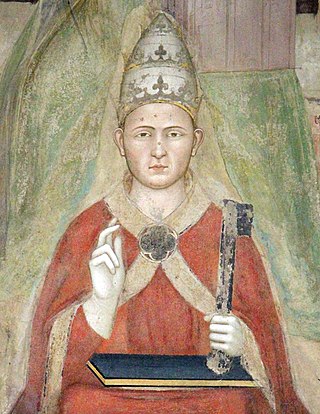
Rome was in disorder due to the ongoing conflict between the Colonna and the Orsini. As soon as Holy Week was over, to escape the violence, Benedict XI withdrew to Perugia, where he died that summer, probably of dysentery. The protracted papal conclave held from 10 or 17 July 1304 to 5 June 1305 in Perugia elected non-cardinal Raymond Bertrand de Got as Pope Clement V. At the time of his election de Got was Archbishop of Bordeaux, and thus a subject of Edward I, King of England, although he was a childhood friend of Philip IV of France. Clement V's decision to relocate the papacy to France was one of the most contested issues in the papal conclave, 1314–1316 following his death, during which the minority of Italian cardinals were unable to engineer the return of the papacy to Rome. This immediately preceded the beginning of the Avignon Papacy.
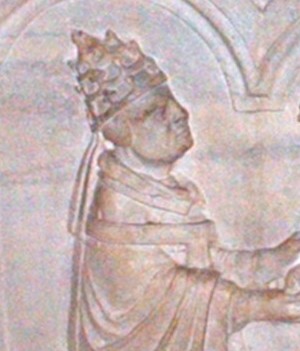
The 1378 papal conclave which was held from April 7 to 9, 1378, was the papal conclave which was the immediate cause of the Western Schism in the Catholic Church. The conclave was one of the shortest in the history of the Catholic Church. The conclave was also the first since 1159 held in the Vatican and in Old St. Peter's Basilica.

A papal conclave was held between 22 September and 28 October 1362 in the Palais des Papes of Avignon to elect the successor of Pope Innocent VI. Guillaume de Grimoard was elected pope and took the name Urban V.

Pierre de Murat de Cros, O.S.B., was a French monk of aristocratic origins who became a cardinal of the Avignon Obedience during the Great Schism, as well as the Archbishop of Arles and the Chamberlain of the Apostolic Camera. Refusing from the day of his election to support Bartolomeo Prignano after the Papal Conclave of 1378, de Cros played a critical role in delivering a considerable portion of the Roman Curia to the rival claimant Robert of Geneva, who took the name Clement VII. Historian Daniel Williman calls Murat de Cros's actions a "counter-coup".
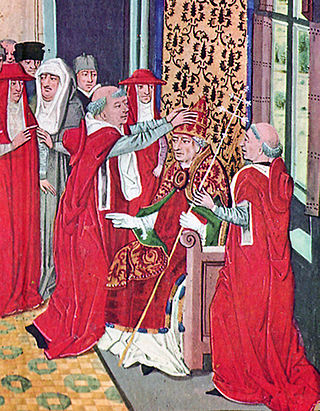
Guy of Boulogne was a statesman and cardinal who served the Avignon Papacy for 33 years. He participated in the papal conclaves of 1352, 1362 and 1370, and was the Subdean of the Sacred College of Cardinals. His diplomatic postings were extensive, including Hungary, Italy, and Spain. He headed an effort to end the Hundred Years' War. The historian Kenneth Setton called him "one of the commanding figures of his day, and the letters of Petrarch abound with references to him".

Raymond de Canillac was a French lawyer, bishop, and cardinal. He was born at Roche de Canilhac, the family castle, in the diocese of Mende in the Gevaudan in central France, the son of Guillaume de Canillac and a sister of Cardinal Bertrand de Déaulx. Both of his uncles, Pons and Guy, were successively abbots of Aniane, as was a nephew of the Cardinal, also called Pons. In 1345 his niece Garine, the daughter of his brother Marquis and of Alixène de Poitiers-Valentinois, married Guillaume Roger, Vicount of Beaufort, the brother of Cardinal Pierre Roger de Beaufort, who became Pope Clement VI. Raymond became a member of the Canons Regular of Saint Augustine (CRSA). He studied law at the University of Montpellier, and obtained the degree of Doctor in utroque iure.
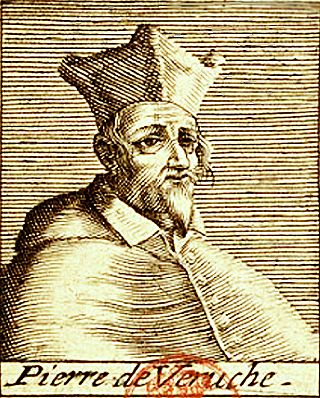
Pierre de la Vergne, aka Pierre de Veruche, Pierre Verneyo, Pierre Veruco, Pierre Verrujo or Pierre Veroche, Latin Petrus de Vernio (died 6 October 1403 in Avignon was a French cardinal.

















